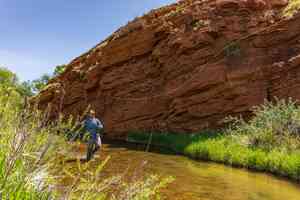The nation's first park announced a ban on felt sole wading boots March 8. It's rubber only when fishing season opens May 26.
"People who are coming to Yellowstone National Park to fish and boat care about park resources and this is just another way to help manage invasive species," says Vicki Regula, Yellowstone National Park public affairs assistant. "That's a definite high priority in Yellowstone National Park because of all the ecological and economical impacts invasives can have on waterways."
Yellowstone has eight aquatic invasives already: two types of mollusks, the New Zealand mudsnail, red-rimmed melania, whirling disease and five types of fish. The five will make your brows rise: brook, brown, bow, lake chub and lake trout.
Park scientists are aggressively working on the lake trout invasion. Managers don't want another problem surfacing so felt is sinking. Anyone caught fishing the park in felt faces up to six months in jail and a fine of up to $5,000.
"I don't think banning felt is the answer," says Todd Lanning, Henry's Fork Anglers, assistant shop manager. "If they don't want invasive species spreading from river to river, they better just ban fishing period."
Lanning sounds extreme, but he has a point. He's based in Island Park, Idaho just outside of the park's West entrance. He fishes the park at least 30 days during its short summer season. Of course he doesn't want everyone kicked out of the creeks, but bad bugs hitch rides on more than boot bottoms. That's the point. Felt is a start, but washing all fishing equipment upon river exit and before entering another waterway reduces more risk.
As discussed in Rubber vs. felt, felt may grab more invasive species, but the problem is beyond boots. Far Bank Enterprises, the makers of Redington felt and rubber sole wading boots, knows that.
"No fish, no fishing. We need to do whatever we can to protect fisheries," says Tag Kleiner, Far Bank Enterprises vice president of marketing. "There will be regulations that come into play that change the way people fish. Change is difficult, but if change is made to protect fisheries and what we love doing then I'm for it."
The park's surrounding states: Idaho, Montana and Wyoming, allow felt. I see fishers stepping out of Idaho's Henry's Fork, Montana's Madison and Wyoming's Gros Ventre into Yellowstone water all the time. Enforcing the felt ban is going to be tough this summer. The learning curve steep. I have both soles and I know their place, especially their place as soon as I step out of the flow. Into the hose sprayer they go with everything else.































Comments
Larry Quilling replied on Permalink
I am disabled and have tough enough time as it is wading with felt. This ban is discriminatory.
Miggity replied on Permalink
Your hose sprayer isn't doing anything to rid your gear of invasives.
Lawrence S. replied on Permalink
Felt is one piece of the puzzle. You can't put one together without all the pieces. We're fine with regulating until those regulations impact us. Our supposed "rights" do NOT supersede the well-being of the environment.
Pages